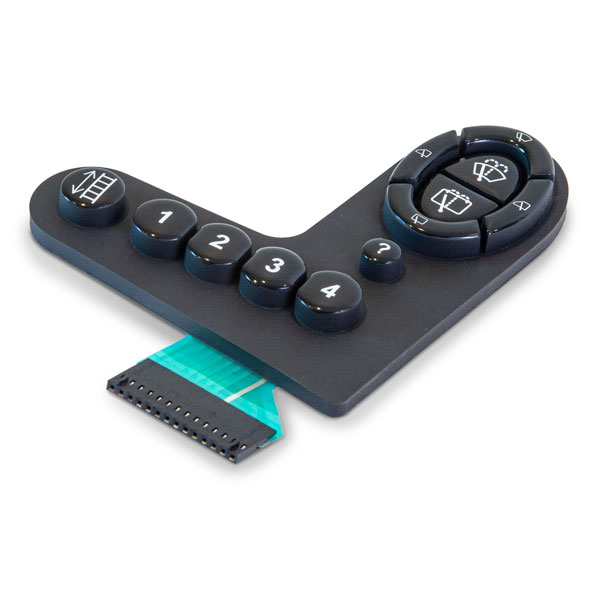How membrane switch supports durability and performance in healthcare
Comprehending the Relevance of Membrane Layer Switch Over in Modern Electronic Devices
Membrane switches are important parts in modern digital gadgets. They use a blend of performance and style that enhances individual interaction. Their resilient and light-weight nature makes them appropriate for different applications. As sectors advance, the need for customization and progressed functions expands. Comprehending how membrane layer changes add to technology exposes their importance fit the future of electronic devices. What lies in advance for this modern technology?
The Basics of Membrane Layer Switch Over Technology
Although usually forgotten, membrane button technology plays an essential role in the modern-day electronics landscape - membrane switch. These devices, made up of several layers, work as user interfaces for numerous electronic products, varying from house appliances to medical devices. A regular membrane button contains a visuals overlay, a spacer layer, and a circuit layer, which are thoroughly assembled to produce a practical interface.When pressure is put on the overlay, the circuit layer is finished, permitting signals to be transmitted to the gadget. This technology is understood for its versatility, making it possible for customization in style, form, and performance to meet particular user needs. Furthermore, membrane switches are lightweight and thin, making them suitable for applications where space is a costs. Their toughness and resistance to ecological factors further improve their allure, guaranteeing they can hold up against severe problems while preserving performance. Generally, membrane layer button modern technology is integral to creating easy to use and effective electronic tools

Secret Advantages of Membrane Layer Switches
Membrane layer changes deal numerous vital benefits that make them a preferred selection in numerous digital applications. Their style enables a portable kind element, enabling producers to produce lightweight and sleek tools. Additionally, membrane layer buttons are immune to dirt, moisture, and chemicals, which boosts their toughness and longevity in requiring atmospheres. The tactile comments given by these switches can boost user experience, making them easy and user-friendly to operate.Furthermore, membrane buttons can be customized with varied graphics and shades, permitting for special branding opportunities. The production procedure is generally economical, especially for high-volume manufacturing, as it reduces setting up time and simplifies style. Lastly, membrane changes call for minimal upkeep, adding to lower general functional expenses. These advantages highlight their expanding popularity in contemporary electronic devices, where dependability and user-friendly interfaces are necessary.

Applications Across Numerous Industries
The flexibility of membrane switches over allows their widespread fostering across numerous sectors. In the clinical field, they are commonly made use of in analysis devices and patient tracking systems, offering a long lasting interface resistant to impurities. The auto market utilizes membrane buttons for control panel controls, boosting user experience with smooth styles that withstand severe conditions. In customer electronics, they function as control panels for devices such as microwaves and coffee machine, offering an user-friendly user interface that is simple to clean. The aerospace industry utilizes membrane layer switches in cabin controls, where dependability and room efficiency are paramount. Furthermore, the industrial field leverages these switches in equipment and control systems to ensure durable procedure sought after environments. This broad variety of applications emphasizes the versatility of membrane layer buttons, making them essential components in improving performance and user interaction throughout diverse technological landscapes.
Personalization and Layout Versatility

Future Patterns in Membrane Layer Change Advancement
Arising patterns in membrane switch development indicate an expanding focus on improved functionality and assimilation with smart innovations. As customer demand for much more innovative electronic gadgets increases, suppliers are concentrating on developing membrane layer switches that not just offer standard functional functions but likewise incorporate functions like touch sensitivity, backlighting, and haptic feedback.Furthermore, developments in products are anticipated to boost longevity and ecological resistance, making membrane switches over ideal for varied why not find out more applications in industries such as medical care, vehicle, and customer electronics. The integration of capacitive touch innovation is most likely to come to be extra prevalent, enabling sleeker styles and improved individual interfaces. membrane switch.Additionally, the increase of the Web of Things (IoT) is prompting the growth of membrane switches that can connect wirelessly with other devices, enhancing interconnectivity. On the whole, the future of membrane button innovation appears appealing, driven by development and the pursuit of user-friendly remedies
Regularly Asked Inquiries
Exactly How Do Membrane Switches Compare to Typical Mechanical Switches?
Membrane buttons, being much more space-efficient and using a streamlined layout, contrast with conventional mechanical switches that provide responsive responses. The former usually include personalized graphics, while the latter normally guarantee toughness and reliability in numerous applications.
What Products Are Typically Utilized in Membrane Switch Manufacturing?
Membrane switches are typically produced using materials such as polyester, polycarbonate, and printed conductive inks. These materials provide flexibility, responsiveness, and longevity, making them suitable for different applications in electronic tools and interface.
Can Membrane Switches Be Fixed or Recycled?
Membrane switches can commonly be repaired, especially if minor problems occur, such as adhesive failing or surface damage. Full reuse is typically limited due to use and prospective destruction of products over time.
Just How Do Ecological Elements Influence Membrane Switch Efficiency?
Environmental factors, such as direct exposure, moisture, and temperature to chemicals, significantly influence membrane button efficiency. Severe problems can cause destruction, impacting responsiveness and long life, eventually compromising the functionality of the tool in different applications.
What Is the Common Lifespan of a Membrane Change?
The typical lifespan of a membrane layer button typically varies from 1 to 5 million actuations, depending on variables such as usage regularity, environmental problems, and the materials made use of in production, impacting sturdiness and efficiency longevity. A typical membrane button consists of a visuals overlay, a spacer layer, and a circuit layer, which are thoroughly set up to develop a useful interface - membrane switch.When stress is used to the overlay, the circuit layer is finished, enabling signals to be transferred to the device. The responsive feedback given by these buttons can improve customer experience, making them very easy and user-friendly to operate.Furthermore, membrane switches can be personalized with diverse graphics and colors, allowing for distinct branding opportunities. As customer need for a lot more innovative digital gadgets useful source increases, suppliers are focusing on producing membrane layer switches that not just serve fundamental operational functions however also integrate features like touch level of sensitivity, backlighting, and haptic feedback.Furthermore, advancements in materials are anticipated to improve toughness and environmental resistance, making membrane switches ideal for diverse applications in industries such as health care, automobile, and consumer electronics. The combination of capacitive touch modern technology is likely to end up being a lot more prevalent, allowing for sleeker styles and boosted individual interfaces.Additionally, the increase of the Internet of Things (IoT) is prompting the growth of membrane layer switches over that can interact wirelessly with other her response devices, enhancing interconnectivity. Membrane buttons, being more space-efficient and providing a sleek design, comparison with conventional mechanical buttons that supply responsive feedback